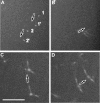Visualization and identification of the structures formed during early stages of fibrin polymerization
- PMID: 21248064
- PMCID: PMC3099577
- DOI: 10.1182/blood-2010-07-297671
Visualization and identification of the structures formed during early stages of fibrin polymerization
Abstract
We determined the sequence of events and identified and quantitatively characterized the mobility of moving structures present during the early stages of fibrin-clot formation from the beginning of polymerization to the gel point. Three complementary techniques were used in parallel: spinning-disk confocal microscopy, transmission electron microscopy, and turbidity measurements. At the beginning of polymerization the major structures were monomers, whereas at the middle of the lag period there were monomers, oligomers, protofibrils (defined as structures that consisted of more than 8 monomers), and fibers. At the end of the lag period, there were primarily monomers and fibers, giving way to mainly fibers at the gel point. Diffusion rates were calculated from 2 different results, one based on sizes and another on the velocity of the observed structures, with similar results in the range of 3.8-0.1 μm²/s. At the gel point, the diffusion coefficients corresponded to very large, slow-moving structures and individual protofibrils. The smallest moving structures visible by confocal microscopy during fibrin polymerization were identified as protofibrils with a length of approximately 0.5 μm. The sequence of early events of clotting and the structures present are important for understanding hemostasis and thrombosis.
Figures






Comment in
-
To gel or not to gel.Blood. 2011 Apr 28;117(17):4406-7. doi: 10.1182/blood-2011-02-332767. Blood. 2011. PMID: 21527539 No abstract available.
Similar articles
-
Does topology drive fiber polymerization?Biochemistry. 2014 Dec 16;53(49):7824-34. doi: 10.1021/bi500986z. Epub 2014 Dec 5. Biochemistry. 2014. PMID: 25419972 Free PMC article.
-
Computer modeling of fibrin polymerization kinetics correlated with electron microscope and turbidity observations: clot structure and assembly are kinetically controlled.Biophys J. 1992 Jul;63(1):111-28. doi: 10.1016/S0006-3495(92)81594-1. Biophys J. 1992. PMID: 1420861 Free PMC article.
-
Electron microscope investigation of the early stages of fibrin assembly. Twisted protofibrils and fibers.J Mol Biol. 1990 Dec 5;216(3):503-9. doi: 10.1016/0022-2836(90)90376-W. J Mol Biol. 1990. PMID: 2258925
-
[Molecular mechanisms of the polymerization of fibrin and the formation of its three-dimensional network].Bioorg Khim. 2009 Jul-Aug;35(4):437-56. doi: 10.1134/s1068162009040013. Bioorg Khim. 2009. PMID: 19928047 Review. Russian.
-
Mechanisms of fibrin polymerization and clinical implications.Blood. 2013 Mar 7;121(10):1712-9. doi: 10.1182/blood-2012-09-306639. Epub 2013 Jan 10. Blood. 2013. PMID: 23305734 Free PMC article. Review.
Cited by
-
Estimating the 3D pore size distribution of biopolymer networks from directionally biased data.Biophys J. 2013 Nov 5;105(9):1967-75. doi: 10.1016/j.bpj.2013.09.038. Biophys J. 2013. PMID: 24209841 Free PMC article.
-
Missing regions within the molecular architecture of human fibrin clots structurally resolved by XL-MS and integrative structural modeling.Proc Natl Acad Sci U S A. 2020 Jan 28;117(4):1976-1987. doi: 10.1073/pnas.1911785117. Epub 2020 Jan 10. Proc Natl Acad Sci U S A. 2020. PMID: 31924745 Free PMC article.
-
Fibrinogen and Fibrin.Subcell Biochem. 2021;96:471-501. doi: 10.1007/978-3-030-58971-4_15. Subcell Biochem. 2021. PMID: 33252741 Review.
-
Novel characteristics of soluble fibrin: hypercoagulability and acceleration of blood sedimentation rate mediated by its generation of erythrocyte-linked fibers.Cell Tissue Res. 2022 Mar;387(3):479-491. doi: 10.1007/s00441-022-03599-9. Epub 2022 Mar 11. Cell Tissue Res. 2022. PMID: 35275281 Free PMC article.
-
Fibers Generated by Plasma Des-AA Fibrin Monomers and Protofibril/Fibrinogen Clusters Bind Platelets: Clinical and Nonclinical Implications.TH Open. 2021 Jul 6;5(3):e273-e285. doi: 10.1055/s-0041-1725976. eCollection 2021 Jul. TH Open. 2021. PMID: 34240000 Free PMC article.
References
-
- Doolittle RF. Fibrinogen and fibrin. Annu Rev Biochem. 1984;53:195–229. - PubMed
-
- Cierniewski CS, Kloczewiak M, Budzynski AZ. Expression of primary polymerization sites in the D domain of human fibrinogen depends on intact conformation. J Biol Chem. 1986;261(20):9116–9121. - PubMed
-
- Fowler WE, Erickson HP, Hantgan RR, McDonagh J, Hermans J. Cross-linked fibrinogen dimers demonstrate a feature of the molecular packing in fibrin fibers. Science. 1981;211(4479):287–289. - PubMed
-
- Weisel JW, Phillips GN, Jr., Cohen C. A model from electron microscopy for the molecular structure of fibrinogen and fibrin. Nature. 1981;289(5795):263–267. - PubMed
Publication types
MeSH terms
Substances
Grants and funding
LinkOut - more resources
Full Text Sources
Other Literature Sources
Medical

